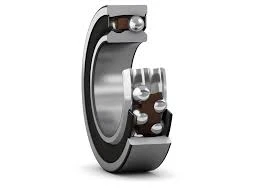
Dec . 18, 2024 03:32 Back to list
taper roller bearing mounting arrangement
Taper Roller Bearing Mounting Arrangement A Comprehensive Guide
Taper roller bearings are widely used in various industries due to their ability to withstand heavy axial and radial loads. These bearings consist of inner and outer rings, tapered rollers, and cages. The unique design allows for a rolling contact that helps reduce friction and wear, thus enhancing the bearing's operational efficiency and lifespan. Proper mounting arrangements are crucial for the optimal function of taper roller bearings. This article explores the various aspects of taper roller bearing mounting arrangements, highlighting best practices and considerations.
Understanding Taper Roller Bearings
Taper roller bearings are designed to accommodate both radial and axial loads, making them suitable for applications like automotive transmissions, wheel hubs, and machinery spindles. They feature tapered rollers, which are positioned in a way that their axes converge at a point. This construction not only enables the bearings to handle significant loads but also facilitates smooth motion by minimizing contact stress.
Importance of Proper Mounting
The mounting arrangement of taper roller bearings directly affects their performance. Incorrect mounting can lead to premature failure, increased friction, and misalignment. Key factors that impact bearing performance include preload, alignment, and clearance.
1. Preload Proper preload ensures that the rollers maintain optimal contact with the raceways. Preloading can be achieved through axial adjustment. Over-preloading may cause excessive friction and heat generation, whereas under-preloading can lead to slack in the bearing, increasing wear.
2. Alignment To ensure even load distribution, taper roller bearings must be aligned accurately. Misalignment can lead to uneven wear and a reduction in bearing life. It is critical to check alignment during the installation process. Tools such as laser alignment systems can help achieve precise alignment.
3. Clearance The clearance between the components of taper roller bearings is another vital consideration. Too much clearance can allow for excessive movement, leading to instability. On the other hand, insufficient clearance can cause binding and increased wear. The optimal clearance will depend on the specific application and operating conditions.
taper roller bearing mounting arrangement

Mounting Techniques
Several techniques can be employed to mount taper roller bearings effectively
1. Direct Mounting In this technique, the bearing is mounted directly onto the shaft or housing. This method is commonly used where space is limited. It is essential to ensure that the mounting surfaces are clean and free from debris to prevent damage.
2. Using Housings Taper roller bearings can also be mounted in housings, which help distribute loads evenly and provide additional support. Housing designs may vary according to the application's requirements.
3. Adjustment Rings Some applications benefit from the use of adjustment rings, which allow for fine-tuning of the bearing preload. This feature is particularly useful in situations where conditions may change over time, affecting performance.
Maintenance Considerations
Regular maintenance is key to ensuring the longevity of taper roller bearings. Inspection routines should include checking for signs of wear, such as pitting or scoring on the raceways. Lubrication is also essential; the right type and amount of lubricant will reduce friction and prevent overheating. Using smart technology, like condition monitoring systems, can help detect issues before they lead to failures.
Conclusion
Taper roller bearing mounting arrangements play a pivotal role in the efficiency and lifespan of machinery. Understanding the dynamics of preload, alignment, and clearance, along with employing the right mounting techniques, can significantly enhance bearing performance. Regular maintenance and timely inspections further ensure that taper roller bearings operate efficiently, thus minimizing downtime and repair costs. By following best practices, industries can harness the full potential of taper roller bearings, ultimately leading to improved productivity and reliability.
Latest news
-
Premium Deep Groove Ball Bearings | High Speed & Reliability
NewsAug.29,2025
-
Durable Scaffolding Clamps - Secure & Reliable Tube Connectors
NewsAug.28,2025
-
Common Failures in Thrust Ball Bearings and Solutions
NewsAug.22,2025
-
How Tapered Roller Bearings Can Take Shock Loads
NewsAug.22,2025
-
Angular Bearings in High-Precision Spindles
NewsAug.22,2025
-
The Impact of Misalignment on Cylindrical Roller Bearing Performance
NewsAug.22,2025
